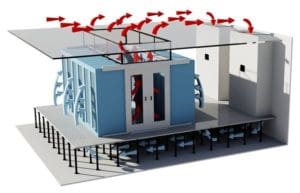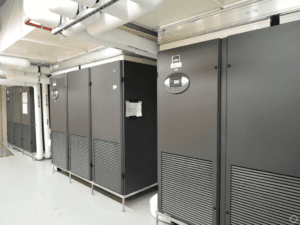Containment systems are essential for maximising energy efficiency and optimising airflow management in your data centre. At EziBlank, we understand the significance of managing your infrastructure investment, and our innovative solutions are designed to do just that. With quick and easy installation, our cutting-edge blanking panels not only enhance performance but also significantly reduce power consumption. Elevate your data centre's functionality and sustainability with our comprehensive range of containment solutions tailored to meet your specific needs.
How to create the perfect data center airflow management plan
Creating the perfect data centre airflow management plan is essential for optimising cooling efficiency, reducing energy consumption, and ensuring the longevity of your equipment. The process begins with a thorough assessment of the current airflow dynamics, identifying any hot spots or areas where air circulation is suboptimal. Key components of an effective plan include the strategic placement of blanking panels to prevent hot air recirculation, proper cable management to avoid airflow blockages, and the use of perforated floor tiles to direct cool air precisely where it’s needed. Additionally, implementing cold or hot aisle containment can further enhance airflow efficiency by separating hot and cold air streams. Regular monitoring and adjustments are crucial to maintaining optimal conditions as the data centre evolves. By focusing on these elements, you can create an airflow management plan that maximises performance and minimises costs.
Read More
Hot Aisle vs Cold Aisle Containment
Hot aisle and cold aisle containment are two critical strategies used in data centres to enhance cooling efficiency and reduce energy consumption. In a cold aisle containment setup, cold air is contained within the aisle where the fronts of the server racks face each other, ensuring that only cool air is delivered directly to the equipment. This prevents the mixing of cold air with hot exhaust air, improving cooling efficiency. Conversely, hot aisle containment involves enclosing the aisle where the backs of the servers expel hot air. This containment captures and directs the hot air back to the cooling systems, preventing it from mixing with the cool air in the room. Both methods are effective, but the choice between hot and cold aisle containment depends on the specific design and cooling needs of the data centre. Implementing either strategy can lead to significant improvements in energy efficiency and overall system performance.
Read More
Hot Aisle Containment Solutions & Products
Hot aisle containment solutions typically include barriers, doors, and ceiling panels that effectively seal off the hot aisle, creating a controlled environment where the separation of hot and cold air is meticulously maintained. This separation ensures that hot exhaust air is directed away from the servers and into return air ducts, preventing it from mixing with the cool intake air and thereby enhancing the efficiency of the cooling system. Implementing these solutions not only significantly reduces energy consumption and lowers cooling costs but also enhances the overall performance, reliability, and lifespan of the data centre’s infrastructure, making it a vital strategy for modern data centres aiming to optimise their operations.
Read More
What is Cold Aisle Containment
Cold aisle containment is a data centre cooling strategy designed to improve energy efficiency and optimise temperature control. In this setup, the cold aisle, where the fronts of the server racks are located, is enclosed to prevent the mixing of cold air with the hot exhaust air from the servers. This containment system ensures that the cool air from the air conditioning units is directed exclusively towards the servers' intake, maximising cooling efficiency. By containing the cold aisle, data centres can maintain lower temperatures with less energy, reducing the workload on cooling systems and lowering overall energy consumption. This approach not only improves the performance and reliability of the equipment but also contributes to significant cost savings and a more sustainable data centre operation. Cold aisle containment is particularly effective in high-density data centres where cooling demands are substantial.
Read MoreWhat is Hot Aisle Containment
Hot aisle containment is a cooling strategy used in data centres to improve energy efficiency by isolating the hot air generated by servers. In this setup, the hot aisle, where the backs of the servers expel warm air, is enclosed, preventing the hot air from mixing with the cool air in the rest of the data centre. This containment ensures that the hot air is directed straight to the cooling units, where it is removed or recycled, thereby reducing the workload on the cooling system. By maintaining a clear separation between hot and cold airflows, hot aisle containment helps to lower energy consumption, enhance cooling efficiency, and maintain optimal operating conditions for the servers, making it a crucial strategy for modern data centre management.
Read More
The Basics of Airflow Management
Airflow management is a fundamental aspect of data centre design that focuses on optimising the cooling process to ensure that IT equipment operates efficiently and reliably. The primary goal is to prevent the mixing of hot and cold air within the data centre, which can lead to hotspots and inefficient cooling. Key strategies include the use of blanking panels to seal off unused rack spaces, directing cool air to where it’s needed most and preventing hot air from recirculating. Additionally, hot and cold aisle containment systems are employed to physically separate the cold intake air from the hot exhaust air, further improving cooling efficiency. Effective airflow management reduces the energy required for cooling, lowers operational costs, and enhances the overall performance and lifespan of data centre equipment.
Read More
Know Your Data Centre Cooling
Understanding your data centre cooling system is essential for maintaining optimal performance and energy efficiency. Effective cooling strategies are crucial in preventing overheating, which can lead to equipment failure and costly downtime. Key aspects of data centre cooling include airflow management, where techniques like hot and cold aisle containment and the use of blanking panels help to direct cool air to the right places while preventing hot air recirculation. Additionally, advanced cooling technologies such as liquid cooling or free cooling can further enhance efficiency by reducing reliance on traditional air conditioning. Regular monitoring of temperature and humidity levels is also critical, allowing for real-time adjustments to maintain optimal conditions. By knowing and optimising your data centre's cooling, you can significantly reduce energy consumption, lower operational costs, and ensure the long-term reliability of your IT infrastructure.
Read More
